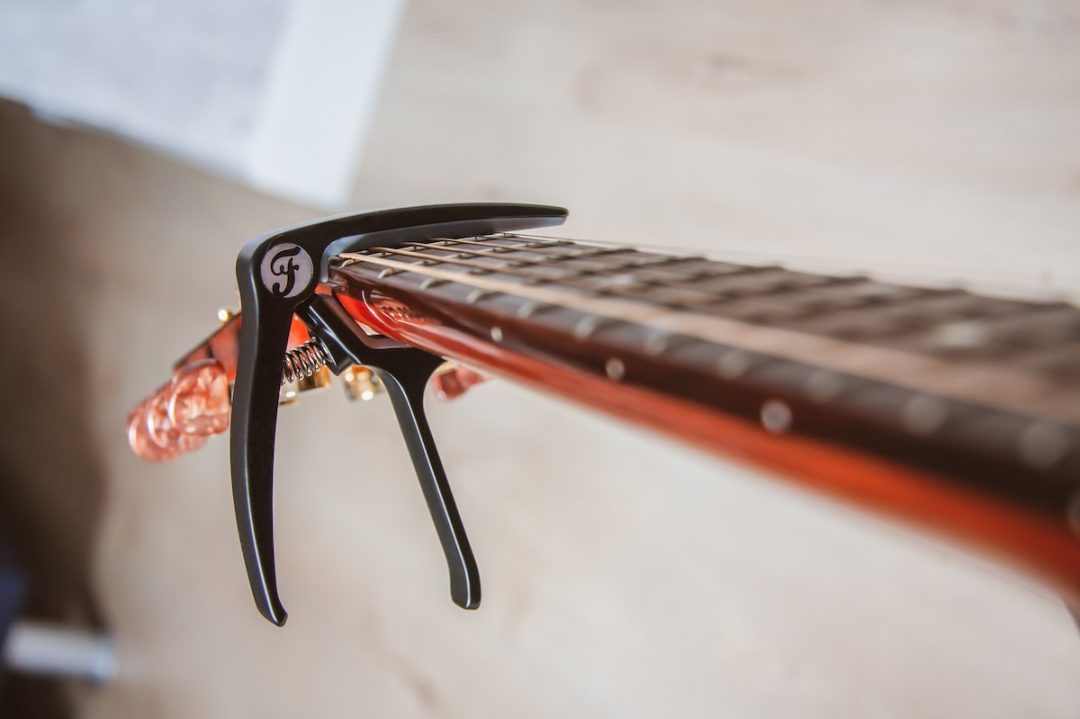As you become more and more invested in playing guitar, you’ll find that the capo is one of those inexpensive accessories with a major impact on the instrument’s sound. Everyone should own one, even if it’s just to experiment with once in a while.
What Is a Guitar Capo & What Does It Do?
A guitar capo is what’s referred to as a moveable nut. You place it on any fret to raise the pitch of all your strings. Assuming we’re in E standard tuning, putting a capo on the first fret changes the E to F; the A to A#; the D to D#; and so on. Lots of singer-songwriters use a capo match the pitch of their voice, and it lets you play open chord voicings in higher keys.
How Does a Capo Work?
Capos usually work with some type of spring mechanism that essentially clamps down across the strings to fret them, and across the back of the neck to hold it in place. They’re also coated in some sort of protective material as to not damage the fretboard or the neck.
Types of Guitar Capos
Since guitar capos all perform the same basic function, size is going to be the most important spec or “type” to consider. Electric guitars often have rounder and smaller necks/fretboards than, say, a classical acoustic. Most companies produce a variety of sizes to accommodate various neck widths and shapes so you can find just the right capo that sits firmly on the fretboard but doesn’t pull your strings out of tune.
- RELATED: The 10 Best Acoustic Guitar Strings to Consider
- RELATED: The 9 Best Acoustic Guitar Pickups for Any Playing Style
The 6 Best Guitar Capo Options to Consider
1. Paige 6-String Standard Guitar Capo
One of the key features in a capo is that it doesn’t ruin your intonation or put awkward tension on the strings that pulls them out of the tune. The Paige standard remedies that problem by putting tension on the strings from the center rather than from the sides. It offers premium tuning stability and is a gig bag staple for many players.
2. Kyser KG6B 6-String Capo – Easy to Use
Here we have the Kyser quick-change spring-based capo. This is a very common type of capo noted for its ease of use and effectiveness. The Kyser in particular is made from durable aluminum with a tough spring that won’t lose tensions over time. It also has protective coatings to not mess up your guitar’s finish.
3. G7th Performance 3 Capo – Best Overall
Believe it or not, you can actually spend quite a bit of money on a capo. What’s so special about this capo is that it adapts to every guitar’s own fretboard radius, eliminating fret buzz as well as tuning issues from strings being pulled out of whack. While not cheap compared to the others, it’s unlikely you’d ever purchase another capo again.
4. Shubb Original C1 Steel String Guitar Capo
Made for steel string acoustic and electric guitars, the Shubb Original is a simple yet effective solution. Similar to the Paige model we saw earlier, the Shubb also employs a style of tension centered over the strings to keep the instrument in tune. This capo also has a unique thanks to its raw brass finish.
5. Ernie Ball Axis Capo – Best Budget Capo
If you’re looking for affordability and simplicity, Ernie Ball nails it with their Axis capo. What’s so cool about this one is not just its price, but its “reversible” design meant to suit any fretboard radius. For the price, you get an awful lot of versatility and a guarantee that it will fit all the guitars in your collection.
Quick Tips for Using Your Capo
Ultimately, the best tip for using your new capo is to experiment with it! Try transposing some of your favorite songs to a different key, or learn new songs that utilize a capo. You’ll find that it’s an inspiring tool when you can so easily alter the totality of your instrument. Plus, they’re so small and unobtrusive that you can keep it permanently in your gig bag for on-the-go inspiration anytime, anywhere.
- RELATED: The 10 Best Travel Guitar Options
